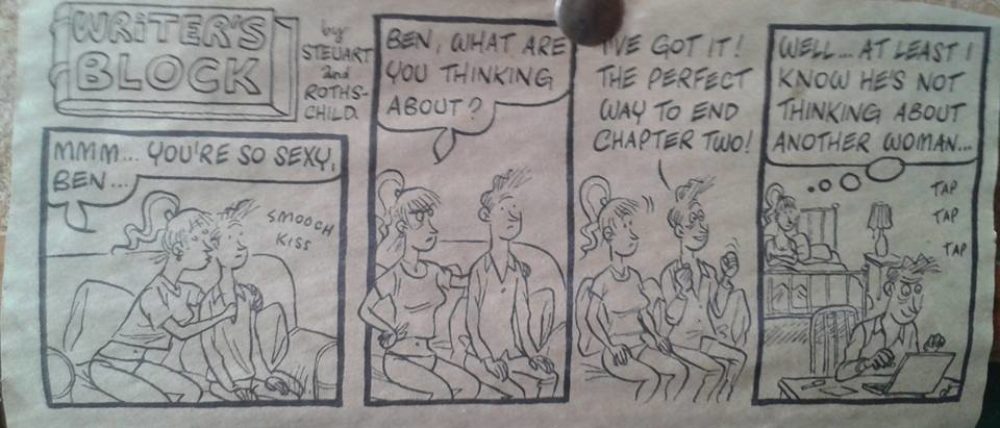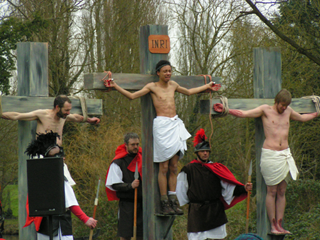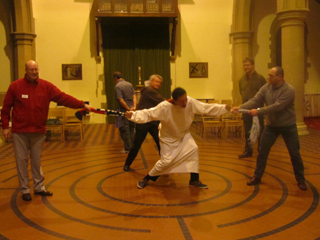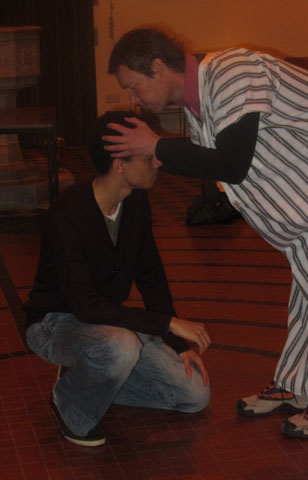We had costumes!
I’m not 100% convinced of the periodicity, but so what. We were clearly and distinctly Roman soldiers, which is what counts. Something that I would really rather not call a surplice, except that it essentially was a surplice; a black faux-leather tunic over; a red cloak, a black belt, and a helmet that was a workman’s hardhat turned around, with added leather bit at the front and a plume gaffered on top. Some of the lads were soldiers all through the production; some of them started off as Temple Guards, then got to put a helmet and a red cloak on and magically transform into soldiers themselves, to swell the ranks for the crucifixion. Nice career path, though I doubt many actual Temple Guards of the time ended up in the Legio VI Ferrata.
We had crosses!
 These were really quite impressive. Hollow, reinforced wooden frames, hinged on their bases for easy elevation, though part of the soldier deployment was to have a man standing on the base at all times to prevent the cross toppling forward and depositing its perp face down on the stage. Jesus’s cross had a detachable crossbar, which was the bit he carried from his trial to Golgotha.
These were really quite impressive. Hollow, reinforced wooden frames, hinged on their bases for easy elevation, though part of the soldier deployment was to have a man standing on the base at all times to prevent the cross toppling forward and depositing its perp face down on the stage. Jesus’s cross had a detachable crossbar, which was the bit he carried from his trial to Golgotha.
In the final run through on Saturday, Jesus protested that he could feel the stage beneath the cross wobbling. I told him it was the earthquake of Matthew’s gospel.
Health & Safety required Jesus to have a safe word: if he said it, he was to be taken off the Cross immediately. Not entirely canonical but we are told to obey the civil authorities …
We had a clear conscience!
A Jewish gentleman got in touch with the producer to express reservations about the whole thing: played wrongly, it is very easy to take an anti-Semitic message away from a Passion Play. Minor revisions were made to highlight the consciences of Nicodemus and Joseph of Arimathea, both senior Jews who tried to stand up to the High Priest, and to make it clear that it wasn’t the Jews who killed Jesus, it was the Romans.
What we didn’t have was weather … Not the right kind, anyway.
We had a wet weather plan, Plan B, which was to fall back into St Helen’s. It’s the largest of the churches, and when it’s almost empty it looks even larger. But it’s still considerably smaller than the Abbey Gardens – which as the name suggests used to contain an abbey. There was almost palpable excitement when everyone – actors + musicians + choir + crowd – started rehearsing together: it was a bit like a ship finally being put together out of all the hull sections that had been made around the country. But, even on our own we packed St Helen’s out. There would be space for an audience of about three.
(Pilate failed to show up to the first all-combined all-through rehearsal, giving me the opportunity to say we should proceed on auto-Pilate. A Facebook friend recommended we go to the nearest Pilates class and get a new one.)
Back to the weather. A week before the show, the crucifixion party had the crosses demonstrated and Chris got a taster of what was to come. It was freezing and wet, very lightly sleeting. We didn’t want to be out in that. But we didn’t want Plan B either.
The last of my extra-curricular assignments was to get the programme typeset and printed. I picked it up on the Friday feeling sick at heart, because snow was forecast for the next day and it was so clear we couldn’t do Plan A. Even though the cover of the programme gaily announced that the show was in the Abbey Gardens.
And then, with a little over 24 hours to go, we got Plan C, which was genius. The kind people of the town council offered us the use of the Guildhall, for free. The Guildhall is right next to the gardens. And there was no precipitation forecast for the Sunday. It would be cold – in the region of minus one – but dry. So, the play would open as planned, and Jesus would enter Jerusalem triumphantly on his (Andalusian) donkey, and so on and so forth, right up to the turning over of the tables and Jesus storming off in search of somewhere he can actually find God. (Remember what I said about narrative drive?) After that the action would move into the Guildhall. The Last Supper, Gethsemane, the Denial, the two appearances before Pilate and one before Herod would all be done indoors, in the warm and dry. After an hour of that, everyone would be nice and toasty and ready to venture out again for crucifixion and Resurrection.
What could go wrong?
We’ll come back to that.
I think the opening market scene was when everyone knew it was going to work. For 45 minutes before the official opening there was a “Jerusalem market” in the formal area of the gardens – stalls, entertainers, entertainments, actors wandering around in character and mingling with the crowd, who all seemed to be loving it. And what a crowd – apparently 1200 were clocked in through the gates. I had deployed the soldiers in pairs to patrol and to stand sentry at the various entrances. One old dear asked one of them, “are you part of the play?” Sadly he didn’t come back with, “what, this old thing? No, it’s just something I threw on …”
I certainly felt the part. Photos may suggest otherwise. I just have to get used to the fact that even when I think I’m scowling and looking well’ard, I am essentially round faced and benign.
And then we came to the first scripted line, a man standing on a barrel and welcoming everyone to Jerusalem … and I couldn’t hear a word. Bugger. Then I could hear a word. And another. And another. Sadly, not the ones in between.
Our heroic sound engineers got it eventually, but because of the sudden adoption of Plan C, the existing sound plot had had to be torn up and started from scratch. Some mikes would work indoors, some would work outdoors, some both. There were already not enough to go round and a schedule had been worked out so everyone knew when to give their mike to someone else … and this was a whole extra layer of complication, not least for those actors with speaking parts inside and out.
And then there was the crowd itself. A lovely, well behaved, very determined crowd of 1200. Which is a lot to squeeze through narrow openings, like the path that connects the two halves of the gardens. They started breaking loose and pushing through the bushes, despite the best efforts of soldiers and stewards to keep them on the right track. But the real fun was when they had to get into the Guildhall. The Guildhall is not a TARDIS; it adheres to conventional geometrical notions by being smaller inside than out. It could have worked better if we had counted heads into the main room up to a certain number, counted them into the overflow room, and firmly told the rest that sorry, you’re not coming in. But even if we had, the sheer mass of people would still have stopped actors surreptitiously meeting up to hand their mikes over. No one in the Pilate scenes was wired – but fortunately they were up on the stage and we just had to talk loud.
(Thankfully someone pushed a mike into my hand as we were leaving the Guildhall for the Way to the Cross. I know it worked at least some of the time because I could hear the crackling over the speakers as I surreptitiously tried to fix it on under my helmet without breaking character. But I still don’t know if anyone heard my immortal lines from the crucifixion.)
For some reason the Guildhall actually had a pair of pillars and Romanesque eagles back stage, so Pilate’s palace actually had a bit of scenery. The first appearance was meant to start with Annas and the Centurion having a battle of wills: Annas adamant that Pilate must come out to see him, Centurion equally adamant that he won’t. But house lights were down and all I could see up on stage was the suggestion of a very large crowd. Somewhere in all that was Annas, shouting his lines. And so I said my bit on cue and – lo! – Annas and the priests appeared up the side stairs. Phew.
Then came the only real bit of improvisation that I noticed all day. As I’m sure everyone knows, Pilate casts around for a reason why Jesus isn’t his problem, and when he learns Jesus is from Galilee, he orders Jesus to be taken to Herod who has responsibility for that area.
Except that this time, Pilate simply ordered, “take him to Herod!” and walked off. Leaving the priests looking a little uncertainly at each other, until Annas remarks, “Because of course Herod has responsibility for Galilee …”
There was mounting excitement inside and out as the Way to the Cross proceeded. Audience members were running past us to get into position at the far end of the gardens – deliberately, the spot where the high altar of the abbey used to be. There was already a line of soldiers in front of the crosses to act as a crowd control barrier and I have to say the scene looked pretty threatening as we approached. Three crosses, two pre-loaded with thieves, and lines of scowling soldiers, just looking back and … waiting. I enjoyed being able to ad lib an order to the legionaries to clear a path through the crowd. Some got into it with relish. One rather let down the might of the Empire with “move aside, please …”
Some of the excitement, of course, was the waiting to see how we were going to do it. But I already knew that. For me, as Chris successfully acted toting a hollow wooden box as if it were a solid beam, there was the increasing feeling that This Was It: the play, like Jesus’s ministry, was all about this moment. This was all planned: this was how it was meant to be. The play was designed to look like an unforeseen sequence of events – but, just like the original, every step was planned. Jesus knew exactly what he was doing and where he was going.
Jesus approached Golgotha knowing that he faced hours of agony, a slow death and the pain of separation from the God he had known and loved all his life. Chris approached it knowing that he would shortly be stripping down to his undies and made to stand for 20 minutes in a strong, sub-zero easterly wind. I don’t know what was going through his mind but I know what would be going through mine. Yet, the only concession I saw him make to the cold was at the end of the choir’s final song, when he had been told to leave a good 15 seconds before his “It is finished.” He gave it about 1.5 seconds, but no one is blaming him.
Apparently the thieves had hot water bottles stuffed down their oversized loincloths, but the Unrepentant Thief still looked perilously close to the first stages of hypothermia with uncontrollable shivering. His cross offered very little shelter from the easterly -1 degree wind. When I last saw him he was fully dressed and drinking a hot cup of tea, so I assume he made it. Our Penitent Thief was a last-minute cast American theology student, who said beforehand that it had always been his favourite Bible scene and it was an honour to take part. Subsequent thoughts are unrecorded.
And then the bodies were taken down, and Jesus was carted off to the tomb, and the crowd dispersed to the Resurrection scene. And for us, the play was over. Back to the Guildhall for tea and what turned out to be cold cross buns.
And, you know what? We made history. We did the first Abingdon Passion Play. If it becomes a tradition, we started it. And it wasn’t just a few Christian nutters: not every actor was a Christian, and quite certainly not every one of that 1200 strong crowd was. But they came. It would be interesting to get statistics on the ones who followed it all through to the end; but, they came.
Next time, in keeping with the weather, we could do The Passion on Ice? Except it would probably be a heatwave.









